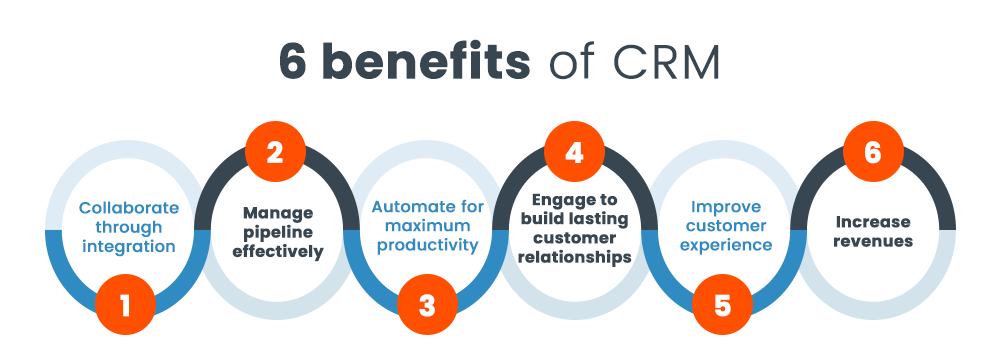Services List
Customer relationship management (CRM) systems are now a must-have for companies that want to keep track of and improve their interactions with customers. A well-implemented CRM system can make marketing, sales, services, and management more efficient. This can lead to a better customer experience and, in the end, more sales. But for CRM to work well, it needs to be implemented in a way that considers the whole business. This detailed guide will walk you through the most important steps and things to think about when implementing CRM. This will help your business succeed by making sure that marketing, sales, services, and operations all work together smoothly.

Covered in this article
Establish clear objectives and define success metrics
Choose the right CRM platform
Map out and standardise processes
Ensure data quality and consistency
Customise and configure the CRM system
Integrate with existing systems
Train your team and encourage the adoption
Monitor, measure, and optimise
Establish clear objectives and define success metrics
Before diving into CRM implementation, it's crucial to establish clear objectives and define success metrics. Align your CRM goals with your overall business objectives, such as increasing customer satisfaction, reducing sales cycles, or improving lead conversion rates. Set measurable key performance indicators (KPIs) to track progress and evaluate the success of your CRM implementation.
- Define your CRM vision: Outline your organisation's long-term CRM goals and how they align with your overall business strategy.
- Identify specific objectives: Break down your CRM vision into specific, achievable objectives for marketing, sales, services, and operations.
- Set KPIs and benchmarks: Determine the KPIs that will help you measure the success of your CRM implementation and establish benchmarks for each metric.
Choose the right CRM platform
Choose a CRM platform that fits your business's size, needs, and money the best. Think about things like scale, customisation, ease of use, and the ability to work with your other systems. Compare the different CRM systems carefully and choose the one that fits your goals and has the features and functions your business needs.
- Identify your CRM requirements: Make a list of the features, functionalities, and integration capabilities that your business needs from a CRM platform.
- Research and compare CRM platforms: Evaluate different CRM platforms based on your requirements, taking into consideration factors like price, scalability, and user experience.
- Test drive your top choices: Request demos or trial versions of your top CRM platform choices to get a hands-on understanding of their features and capabilities.
Map out and standardise processes
For a successful CRM implementation, it's essential to map out and standardise processes across marketing, sales, services, and operations. Identify bottlenecks, inefficiencies, and areas for improvement. Streamline and standardise processes to ensure consistency, facilitate collaboration, and simplify data entry and management within the CRM system.
- Conduct a thorough process audit: Review your current processes across marketing, sales, services, and operations, identifying areas for improvement and standardisation.
- Streamline and optimise processes: Redesign processes to be more efficient and effective, eliminating bottlenecks and redundancies.
- Document standardised processes: Create detailed documentation of your standardised processes, including process flows, roles, and responsibilities, to serve as a reference for your team.
Ensure data quality and consistency
For CRM to work well, it needs data that is accurate and reliable. Set up rules for entering data, make some areas required, and put in place data validation rules to make sure data quality and consistency throughout the CRM system. Check and clean up your CRM data on a regular basis to avoid duplicate, old, or wrong information.
- Develop data entry guidelines: Create a set of guidelines for data entry, including naming conventions, required fields, and formatting rules, to maintain data consistency.
- Implement data validation rules: Set up data validation rules within your CRM system to prevent incorrect or incomplete data entry.
- Schedule regular data audits: Conduct periodic data audits to identify and address data quality issues, such as duplicates, missing information, or outdated records.

Customise and configure the CRM system
You can change and set up the CRM system so that it fits your business's methods, language, and reporting needs. You can adapt the platform to your sales process, make custom fields and modules, and set up automation rules to make marketing, sales, customer service, and operations chores easier. Make sure the CRM system is easy to use and fits the way your team works.
- Adapt the CRM to your business processes: Customise the CRM system to mirror your standardised processes, ensuring a smooth transition for your team.
- Create custom fields and modules: Add custom fields and modules to capture the unique data elements required for your business and industry.
- Set up automation and workflows: Configure automation rules, triggers, and workflows within the CRM system to streamline routine tasks and improve team efficiency.
Integrate with existing systems
Integrating your CRM with other systems, like marketing automation tools, email clients, and customer support software, is important for smooth information flow and increased efficiency. Check to see if the CRM tool you choose will work with your other systems, and then use native integrations or custom API solutions to connect everything smoothly.
- Assess integration requirements: Identify the systems and tools your organisation currently uses that need to be integrated with your CRM system.
- Explore native integrations and custom solutions: Determine whether your chosen CRM platform offers native integrations for your existing systems, or if custom API solutions are necessary to achieve seamless connectivity.
- Test and optimise integrations: After integrating your CRM with existing systems, test the functionality and performance of the integrations, and make any necessary adjustments to optimise data flow and user experience.
Train your team and encourage the adoption
User adoption is critical to the success of your CRM implementation. Provide comprehensive training to your team, covering system navigation, data entry, and best practices for utilising CRM features and functionalities. Encourage user adoption through clear communication, ongoing support, and regular follow-ups to address any challenges or concerns.
- Develop a comprehensive training program: Create a training program that covers all aspects of the CRM system, from basic navigation and data entry to advanced features and functionalities.
- Provide ongoing support: Establish a support system for your team, offering resources, guidance, and assistance in using the CRM system effectively.
- Foster a culture of CRM adoption: Encourage your team to embrace the CRM system by highlighting its benefits, celebrating successes, and addressing any concerns or challenges that arise.
Monitor, measure, and optimise
Once your CRM system is up and running, you should keep an eye on its performance and compare it to the success metrics you set up ahead of time. Look at how users are using the CRM system, how good the data is, and how it affects your marketing, sales, services, and operations. Find places where the CRM system can be improved and tweak it to make it work as well as possible.
- Track KPIs and success metrics: Regularly review your CRM success metrics, comparing them against your established benchmarks to evaluate the performance of your CRM system.
- Identify areas for improvement: Analyse the data and user feedback to identify areas where the CRM system can be further optimised or enhanced.
- Implement optimisation strategies: Make necessary adjustments to the CRM system, whether it be through customisation, configuration, or user training, to continually improve its performance and impact on your business.




